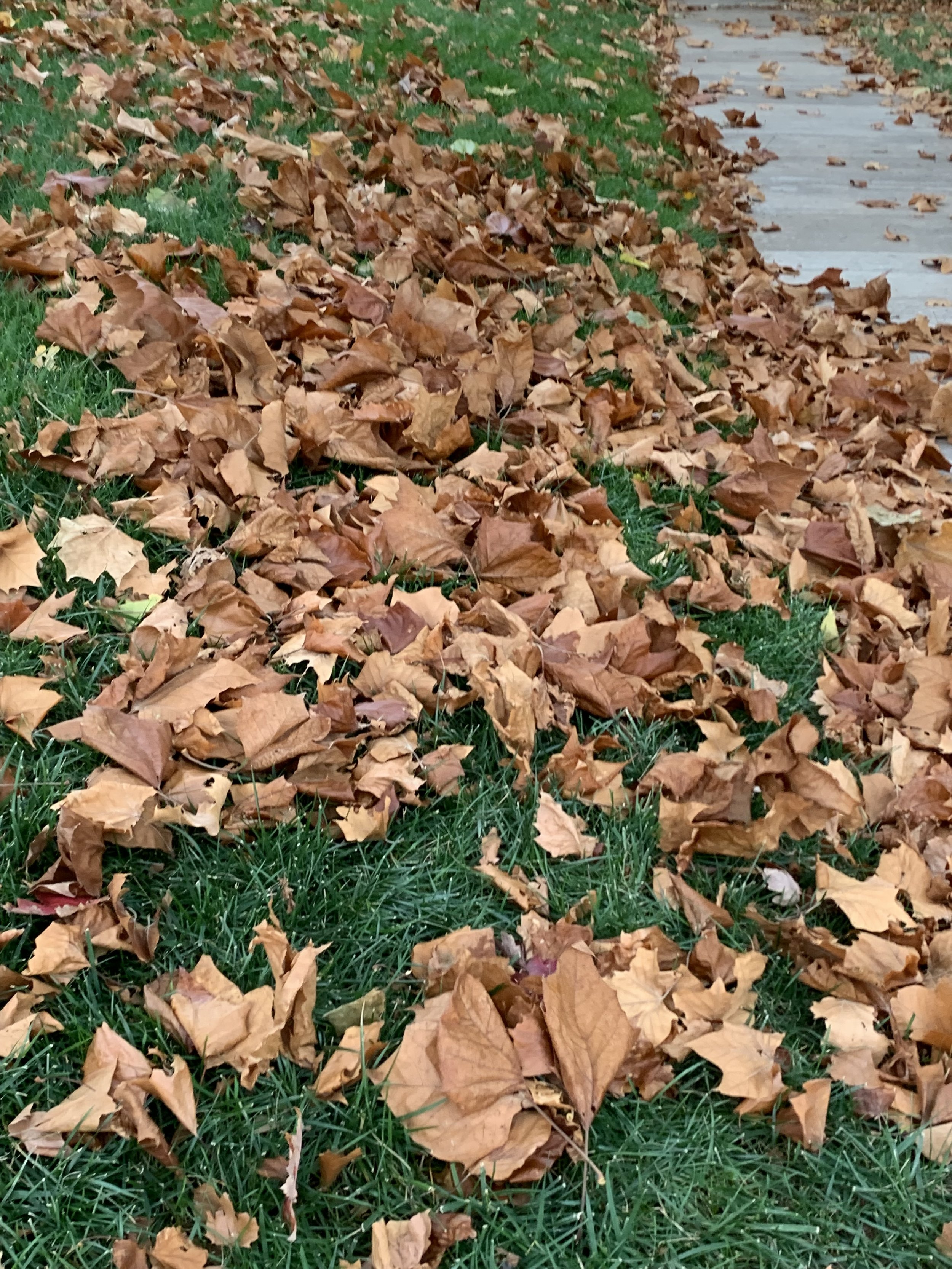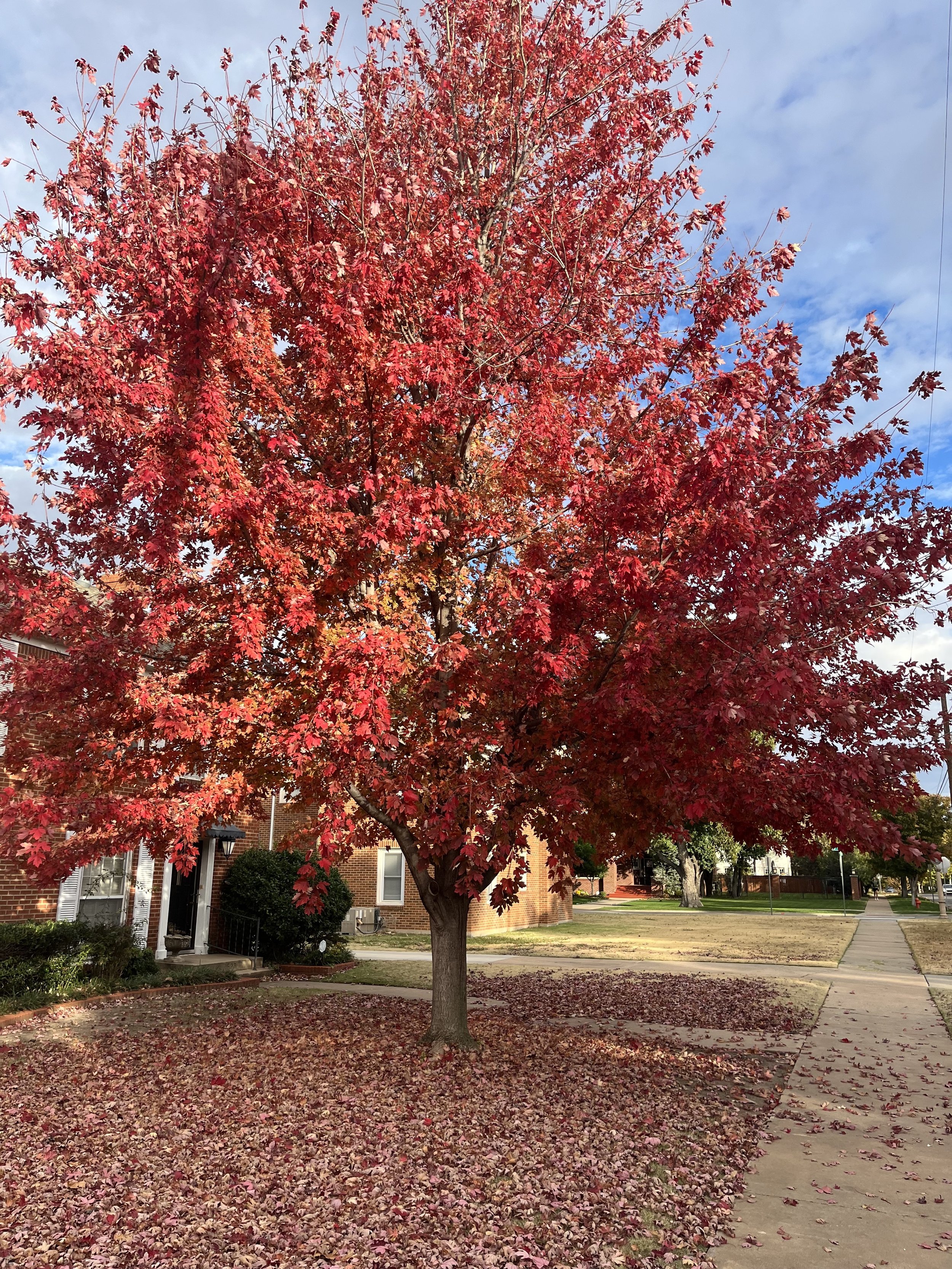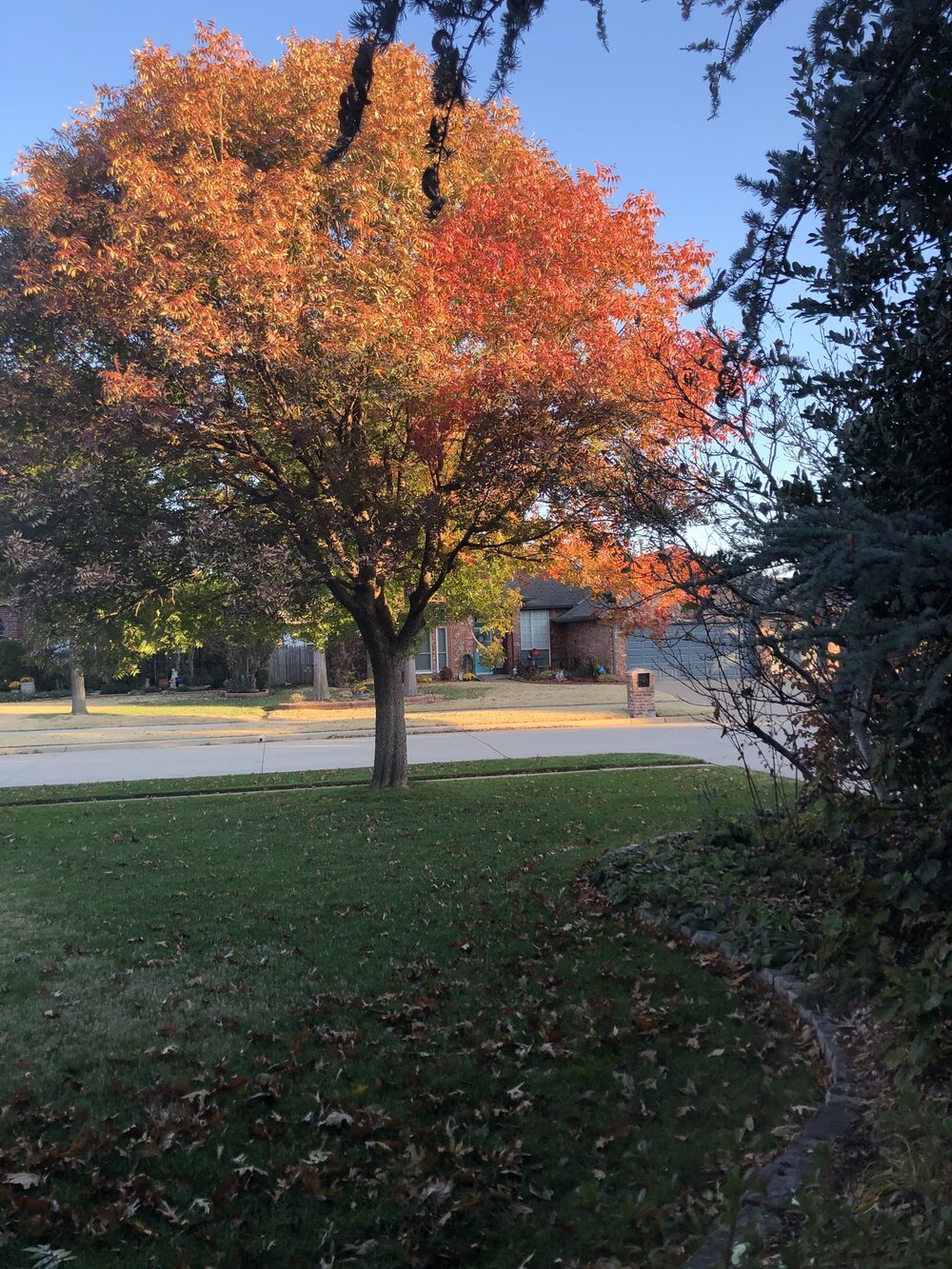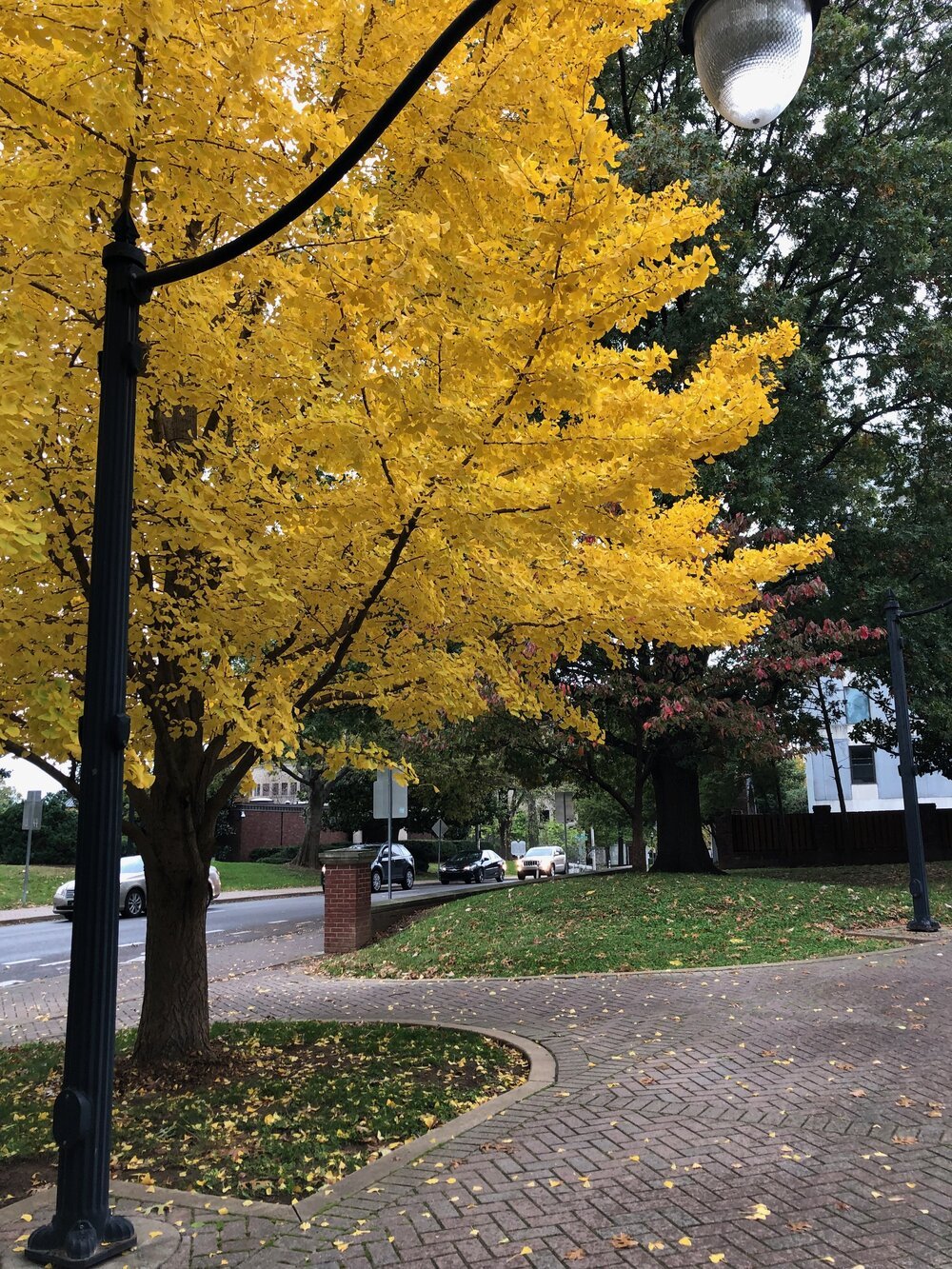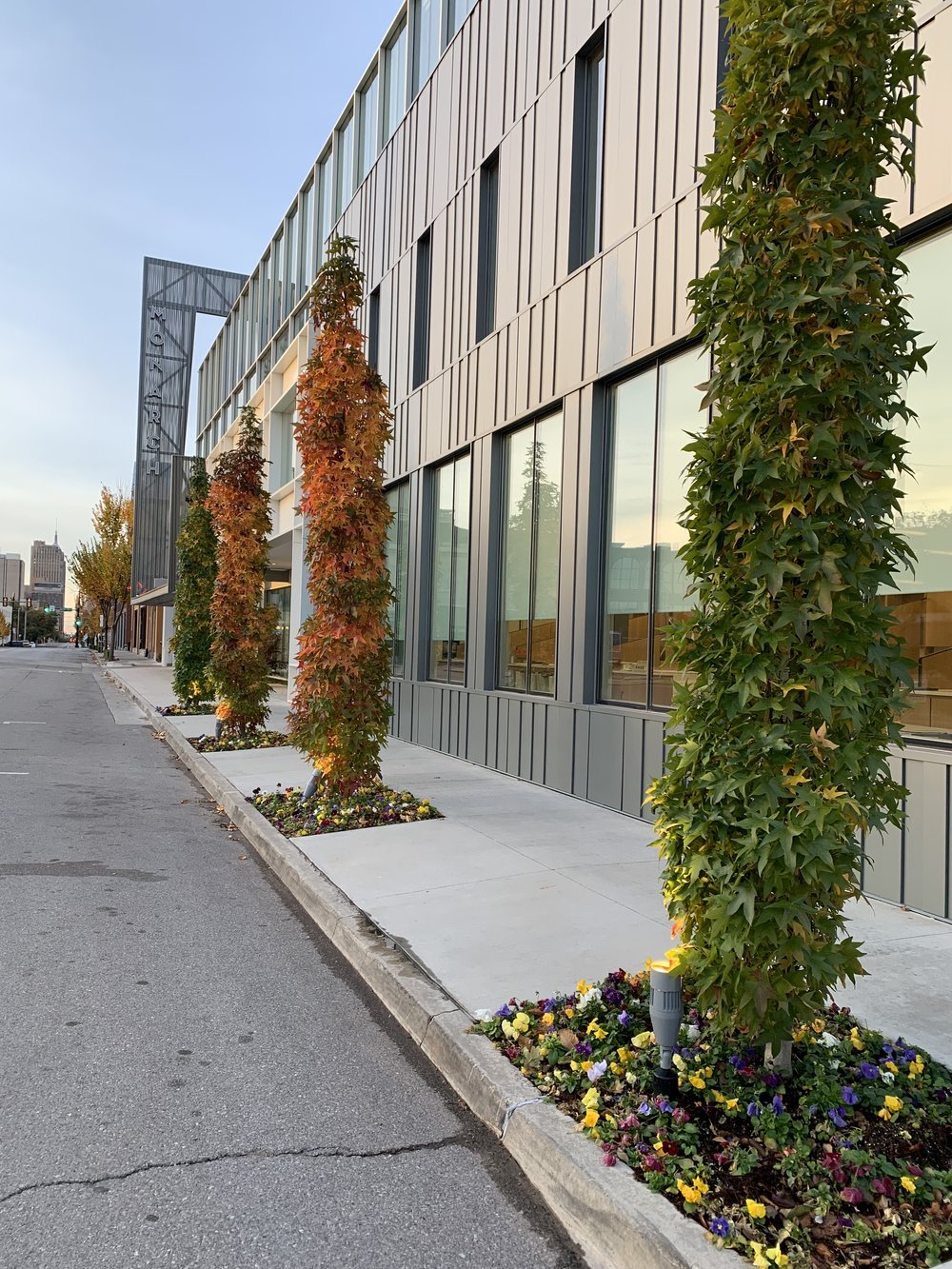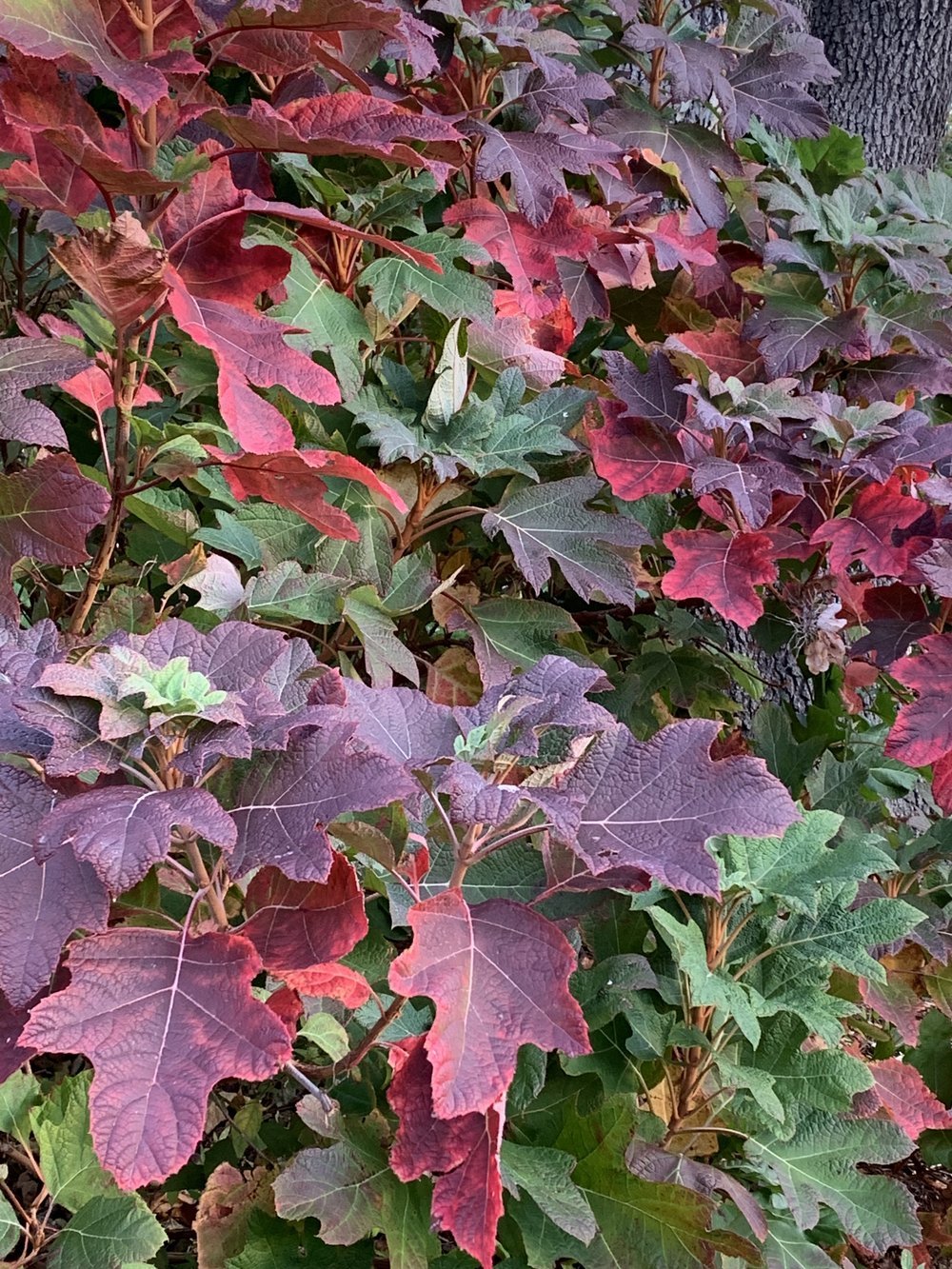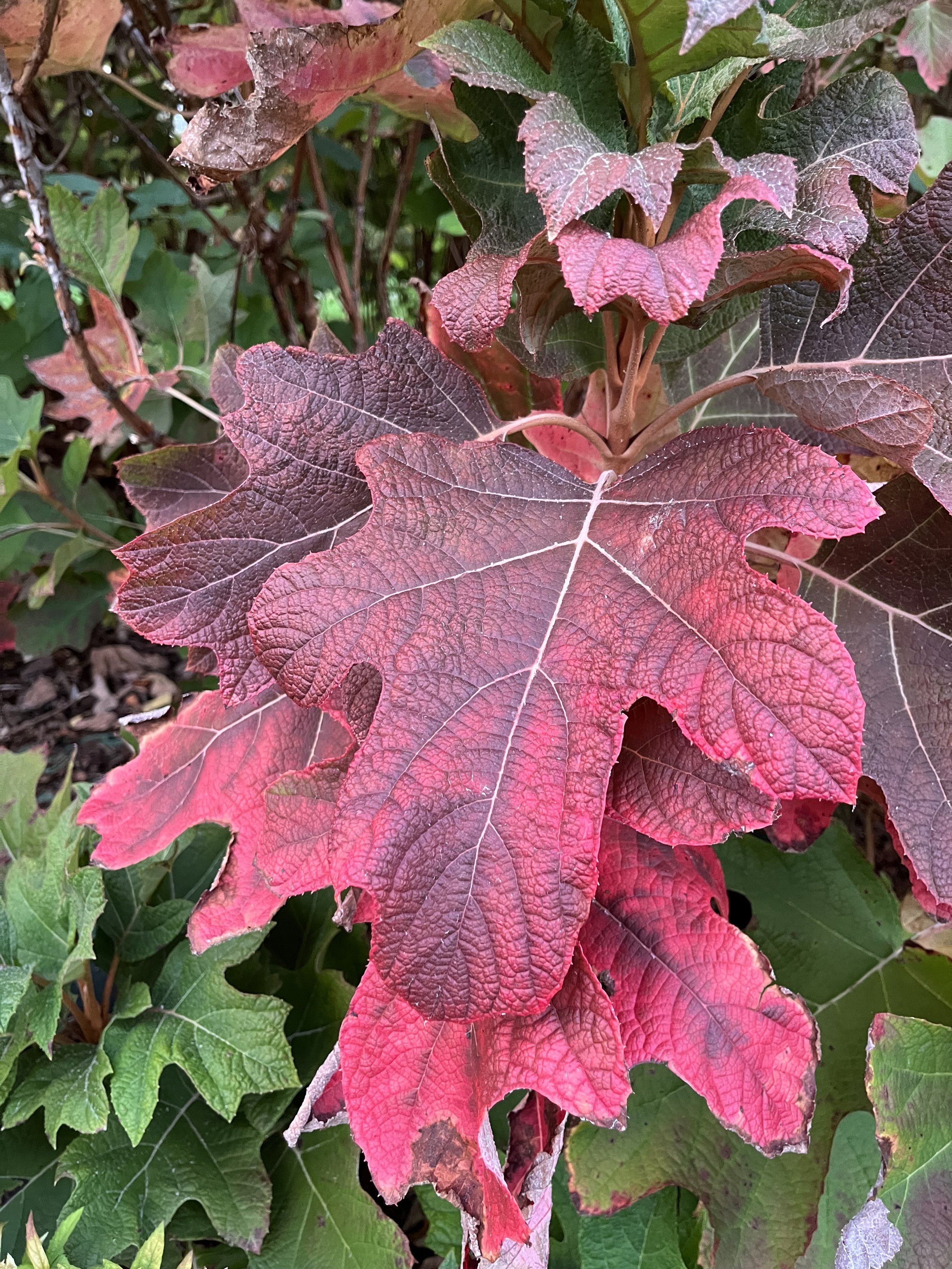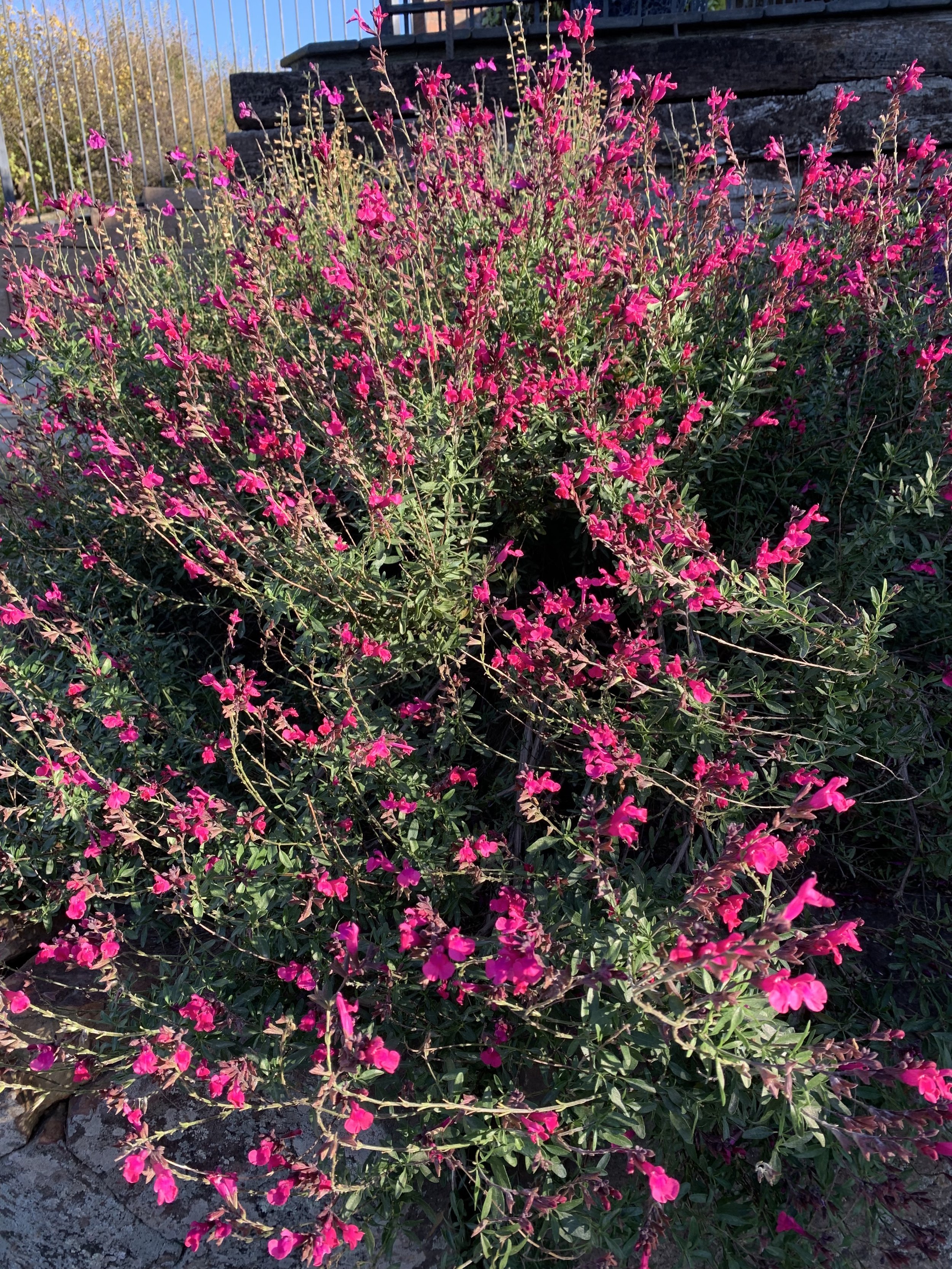Plan a walk through a neighborhood with mature trees full of fall color this week.
Who doesn’t love all the colors of fall!
It’s time to get outdoors!
Plan a color walk through your favorite neighborhood or park, take a leisurely bike ride through a neighborhood full of mature trees, or take an afternoon drive to southeastern Oklahoma.
Now is the time to take a break from your busyness, get outside, and enjoy the colors of fall.
Yellow leafed Japanese Maples add bright pots of yellow to the fall landscape.
Fall color depends upon a few key elements:
1. Abundant moisture during the growing season.
The best fall color follows a summer of consistent moisture. When we have a below-normal, dry summer, you can expect to see a slightly less dynamic fall color.
2. Average to late freeze.
The average first freeze in central Oklahoma occurs during the first few days of November. This year it came on October 30th. When it comes to the first fall freeze, the best fall color occurs when the first freeze comes late, and it is a light freeze.
3. Cool fall nights with plenty of sunshine.
The more average cool fall nights, nights above freezing, the better the fall color. Also, the more sunny days versus cloudy days, the more dynamic the colors will be.
4. Low winds.
Once the leaves make the change to brilliant yellows, oranges, and reds, the last thing we want is a gusty day stripping the trees. Once leaves start to turn, low to no wind days will extend the color.
Based on these four elements, I would say we are having an average to slightly above-average fall color display this year. A dry late summer didn’t help. Three mornings with temperatures in the mid-20s didn’t help. But, we are having plenty of cool nights and sunshiny days. And, we haven’t had too many windy days.
Just a reminder to keep the leaves cleaned up often. Fescue needs light!
I always look forward to seeing this maple in Mesta Park every fall.
Nandina is an old time plant that showers us with large berry clusters followed by bright orange, red leaves as the fall progresses.
Peak fall color for central Oklahoma starts the last week of October
and extends through the first two weeks of November.
Pyracantha
What is your favorite fall tree or shrub?
What is mine? The one that just got my attention! Every day I have a new favorite.
But, here are a few that I always look forward to seeing in the fall landscape:
Boston Ivy is a deciduous vine that turns bright red in the fall.
Autumn Blaze Maples are the first maples to announce it is fall.
Looking for a place to take leisurely fall color bike ride? Start on NW 14th in Heritage Hills and discover this Autumn Blaze Maple.
Autumn Blaze Maple. This was the first bright red tree I saw this fall.
Autumn Blaze Maple – One of the first trees to start the show with bright orange to red foliage. I’m sure you have noticed them. Often the heat of late summer will leave Maples with tattered leaves and less fall color, which may be the case this year. Maples do best when they have protection from late evening, radiant heat. This explains why you will find some of the brightest reds on maples planted amongst other large trees.
Chinese Pistache is a dependable medium sized tree that is tolerate of a wide range of planting locations.
Possibly the most dynamic Chinese Pistache I have seen this year.
Just to show you how much the colors of Chinese Pistache can very. A half block from the dynamic red one was this one with bright orange and yellow leaves.
The Chinese Pistache at NW 18th and Shartel Avenue during the fall of 2020.
Chinese Pistache – A round-top, medium-sized tree, with incredible colors of yellow, orange, and red in the fall. The best Chinese Pistache are so electric you would think they are plugged in. The only downside to a Chinese Pistache is inconsistency. Not everyone will have dynamic color. We have one in our front lawn, the color is good, but not as brilliant as others. The curve at NW 18th & Shartel Ave is planted with ones with dynamic red color most falls.
There is something about the way the late afternoon fall sun hits the changing leaves of a bald cypress that makes you stop and pause.
Bald Cypress – Known for being the only deciduous needle tree, the bald cypress has a brilliant rusty red color in the fall. It is a large tree, too large for the typical city-sized yard, but if you have a large area, it will not disappoint in the fall. We have one planted near the water and we can count on it consistently putting on a good fall show. There is something about how the late evening sun hits the color-changing foliage in the fall that causes me to pause for a minute and stare every evening.
Lacebark Elm – A large tree with mottled bark that is not as disease and pest-prone as the traditional elms. You can expect bright yellow leaves for the fall. A favorite variety is the Allee with its vase shape.
October Glory Maple is similar to the Autumn Blaze in growth and color but puts on a color show a couple weeks after the Autumn Blaze
October Glory Maple adds orange-red to red color to the landscape just a little latter than the Autumn Blaze Maple.
October Glory Maple – Another large Maple like the Autumn Blaze in growth and fall color. One difference is the October Glory’s peak color usually comes a couple of weeks later than the Autumn Blaze. While Autumn Blaze is one of the first trees to turn red in the fall, October Glory is one of the last. Maybe every landscape should have one of each.
Shantung Maple
Shantung Maple is a smaller tree with brilliant golden yellow to orange fall color.
Shantung Maple – A smaller, 20-25’ Maple with yellow to orange to red color. This tree is ideal for planting near power lines, in smaller lawns, or as an accent tree in a larger landscape.
I enjoy the view of our neighbor’s maple trees every fall and I’m so thankful they added them to their landscape!
Caddo Maple – A large, 50-75’ Sugar Maple that has great orange to red fall color. Caddo Maple is a little more suited to our hot west sun than the Autumn Blaze and October Glory.
The reddish browns of Shumard Oak rarely disappoint.
Shumard Oak
Shumard Oak – There are so many great oaks, but this is my favorite. A large, 50-75’ tree with good red fall color. One advantage to the Shumard Oak is it’s more tolerant of our alkaline soils.
Redbud – A smaller tree, famous for being one of the first to flower in the spring, but often overlooked for its bright yellow fall color. The native Eastern Redbud has better fall color than the improved Oklahoma Redbud but can disappoint if the summer has left the leaves tattered.
Ginkgo
Ginkgo – An underused, 40-60’ tree that does very well in street plantings. The Ginkgo has a distinct, fan shaped, irregularly notched leaf that could lay claim to the best yellow fall color.
Silhouette Sweetgum are a great tree for adding bright fall color to small spaces.
Sweetgum may be the most perfect tree with star-shaped dark green leaves that turn wonderful shades of yellow, orange, red, and purple lasting late into the fall. (Perfect except for those annoying spiky seed balls that litter your lawn.)
Ginkgo
Slender Sihouette Sweetgum is columnar shaped and great for tight spaces and crest a wonderful vertical accent.
Sweet Gum
Sweet Gum – If it weren’t for the spiny, 1-1.5” seed balls that litter a lawn, this tree would be on every landscape enthusiast’s wish list. When you see a sweetgum in the fall, it immediately gets your attention because of the multicolored leaves. The star-shaped leaves turn shades of yellow, orange, red, and purple often persisting late into the fall. The tree performs well in both wet and dry soils and reaches 50-60’. The Slender Silhouette variety is a columnar-shaped Sweetgum that reaches 40-50’ but is only 4’ wide. It is great for tight spaces, small gardens, and any place you want to create a striking vertical accent. Just like the full-sized tree, it is common for there to be several rich colors on the same tree.
This allee of single trunk Crape Myrtles at the Myriad Gardens is a great example of the fall color Crape Myrtles add to the landscape when we allow them grow to their natural size as trees instead of excessively pruning them every spring into large shrubs.
Ash
Ash – Marshall’s Seedless Ash is a proven variety with dark green foliage and bright yellow fall color. Ash is known for its tolerance of hot, dry winds and both wet and dry soils, making them well suited for our climate.
Ash
Crape Myrtles – Our longest blooming landscape plant is too often overlooked for the orange to red fall colors it brings to the landscape. Incorrectly, Crape Myrtle are pruned into large shrubs, and we rarely get to experience their splendor in the fall as a tree. When allowed to grow naturally, you find their addition to the fall landscape stunning.
A Dogwood growing in a native area in eastern Oklahoma.
Dogwoods – A rarely planted tree in central Oklahoma that makes a great understory tree in shady areas with dark red fall color. If you have mature trees in your landscape, consider adding a dogwood as an accent. The Tulsa area is blessed with an abundance of fall color from dogwoods.
Euonymus Burning Bush
Burning Bush looks great on groupings or as a single specimen.
Euonymus Burning Bush
Euonymus Burning Bush – A medium to large shrub with a bright red fall color. Like the Chinese Pistache, they can be inconsistent. Also known as Winged Euonymus. When it is over-pruned, it doesn’t reach its full potential. When it is left to grow to its natural shape and height, and it has received sufficient moisture through the summer, the fall color is intense and more consistent than any other plant. It is a great planted as a single specimen, in a grouping, or as a natural hedge. For smaller landscapes, plant the ‘Compactus’ variety.
Oakleaf Hydrangea are know for their white flowers in early summer, but with their large burgundy colored leaves also put on a great fall show.
Oakleaf Hydrangeas are often overlooked for their rich red fall color.
Oakleaf Hydrangea
Oakleaf Hydrangea - One of the most underutilized, showy plants available. Known for magnificent white flowers in the early summer, but it is often overlooked for the rich burgundy color of the large, lobed leaves in the fall. It prefers moist, rich, well-drained soil and is best planted in shade to partial shade.
Ornamental grasses can also add brilliant colors to the fall landscape. One of my favorites is Pink Muhly.
Pink Muhly Grass - An upright, slightly arching ornamental grass that produces a soft, airy pink to purple bloom in late September to early November. Great planted as a single specimen or as a mass planting.
Autumn Sage is a perennial that adds bright pinks to the fall landscape.
Autumn Sage
Autumn Sage - A showy perennial that adds prolific hot pink color to the fall landscape. Great for hot, sunny locations.
Sumac also adds interest to the fall landscape as an understory plant.
There are several varieties of Sumac each with their own dynamic fall color.
Sumac
Sumac
Sumac - Used as a large shrub or a specimen small tree with great tolerance for dry, poor soils. Sumac has a bright red fall color. It is best known for the bright red color it adds to the native landscape, but it deserves to be planted in more landscapes as an understory.
Did you notice the list of great fall color includes more than trees?
Don’t overlook all the colors shrubs, vines, and perennials add to the fall landscape.
Get outside!
Maybe you will find a tree or shrub you need to add to your landscape!
Lorne Hall
Hall | Stewart Lawn + Landscape
(405)367-3873




